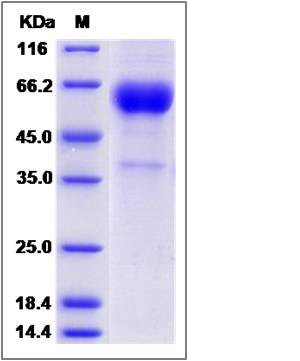Cynomolgus NKp80 / KLRF1 Protein (Fc Tag)
KLRF1
- 100ug (NPP4439) Please inquiry
| Catalog Number | P90165-C01H |
|---|---|
| Organism Species | Cynomolgus |
| Host | Human Cells |
| Synonyms | KLRF1 |
| Molecular Weight | The recombinant cynomolgus KLRF1 comprises 426 amino acids and has a calculated molecular mass of 47.8 KDa.The apparent molecular mass of the protein is approximately 59 KDa respectively in SDS-PAGE. |
| predicted N | Glu |
| SDS-PAGE |  |
| Purity | > 90 % as determined by SDS-PAGE |
| Protein Construction | A DNA sequence encoding the cynomolgus KLRF1(Q8MI05) (Val66-Tyr231) was expressed with the Fc region of human IgG1 at the C-terminus. |
| Bio-activity | Measured by the ability of the immobilized protein to support the adhesion of U937 human histiocytic lymphoma cells. When 5 x 10E4 cells/well are added to KLRF1-coated plates (5 μg/mL, 100 μL/well), > 40% cells will adhere after 1 hour at 37℃. |
| Research Area | Cancer |Signal transduction |ITIM/ITAM Immunoreceptors and Related Molecules |
| Formulation | Lyophilized from sterile PBS, PH 7.4. 1. Normally 5 % - 8 % trehalose, mannitol and 0.01% Tween80 are added as protectants before lyophilization. Specific concentrations are included in the hardcopy of COA. |
| Background | NKp80, also known as KLRF1, is an activating homodimeric C-type lectin-like receptor which is expressed on nearly all natural killer cells and stimulates their cytoxicity and cytokine release. NKp80 stimulates cytotoxicity upon engagement of its genetically linked ligand: myeloid-specific CTLR activation-induced C-type lectin (AICL). NKp80, but not NKp80 mutated at tyrosine 7 (NKp80/Y7F), is tyrosine phosphorylated. Accordingly, NKp80/Y7F, but not NKp80/Y30F or NKp80/Y37F, failed to induce cytotoxicity. NKp80 phosphopeptides comprising the hemi-ITAM-like sequence surrounding tyrosine 7 bound Lck- and Syk-family kinases; accordingly, cross-linking of NKp80, but not NKp80/Y7F, induced Syk phosphorylation. Moreover, inhibition of Syk kinase, but not ZAP-70 kinase, impaired cytotoxic responses through NKp80. Atypical residues in the hemi-ITAM-like motif of NKp80 cause an altered stoichiometry of phosphorylation but did not substantially affect NK cytotoxicity. Altogether, these results show that NKp80 uses an atypical hemi-ITAM and Syk kinase to trigger cellular cytotoxicity. |
| Reference |
